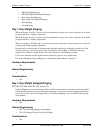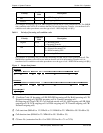
64 DBS 576 (USA), Revised 6/11/98 576-13-700
Chapter 3. System Features Section 700 - Operation
For example, an outgoing call is an ARS Outgoing call (G) but it is also a transferred call. The SMDR
data condition code will be T to indicate that the call was an Outgoing Transfer. (A transferred call’s
condition code takes precedence over the type of call - ARS Outgoing call [G].)
Table 8. Priority of incoming call condition codes
For example, an incoming call is a DID.DDI Incoming call (D), but it is also a transferred call. The
SMDR data condition code will be t to indicate that the call was an Incoming Transfer call. (A
transferred call’s condition code takes precedence over the type of call - DID.DDI Incoming call [D].)
Figure 1. Output data format
Condition Code: (
I
: Incoming call /
D
: DID.DDI incoming call /
h
: Hold incoming call /
N
:
Network incoming call /
S
:DISA incoming call /
t
: Transfer incoming call /
O
: Outgoing call [Non LCR] /
F
: Call forward outside call /
G
: ARS outgoing call /
H
: Hold
outgoing call /
L
: LCR outgoing call /
s
: DISA outgoing call /
T
: Transfer outgoing call /
W
:
Network outgoing call)
Call start time (MM=01 to 12 / DD=01 to 31 / HH=00 to 23 / MM=00 to 59 / SS=00 to 59)
Call duration time (HH=00 to 23 / MM=00 to 59 / SS=00 to 59)
CO user No. (extension line No.: 0 to 9999 / CO line No.: C1 to C576)
4th
L L = LCR Outgoing Call
Lowest
O O = Outgoing Call
Priority
Condition
Code
Description
Highest
h or t h = Incoming Hold
t = Incoming Transfer
2nd
D, N, or S D = DID.DDI Incoming Call
N = Network Incoming Call
S = DISA Incoming Call
Lowest
I I = Incoming Call
Priority
Condition
Code
Description
H
H
1
2
3
4


















